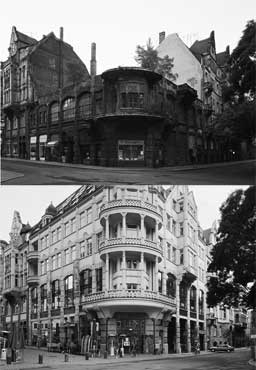(Spiegel, Solveig Grothe) – During a trip to East Germany in 1990, photographer Stefan Koppelkamm discovered buildings that had survived both the war and the construction mania of the East German authorities. Ten years later, he returned to photograph the buildings again. The comparison threw up some unexpected contrasts.

- Leipzig in 1990 – 45 years after the end of the war the once-elegant Art Nouveau building on Fleischergasse is now in ruins. A “people-owned” betting shop operates from the ground floor.
Leipzig 2002 – Barfussgässchen has become a pedestrian zone. The building has been transformed and is hardly recognizable.
Footsteps echoed on the cobblestones in the narrow street. The photographer carried a large plate camera over his shoulder. Fascinated, his searching gaze wandered over the lavish Renaissance portal entranceways, the balconies with filigree railings and the elaborate stucco facades. The plaques above the doorways bore witness to a brisk business in the neighbourhood: Bicycles and Motorcycles, est. 1907 read the sign above one of the shops. Others read Schindler’s Floral Hall or Printing Society and Publishing House. But on the street itself there wasn’t a soul to be seen.
Back at home Koppelkamm laid out his photos next to one another, old and new. Suddenly he was surprised by what he saw in front of him. Zittau was particularly striking: the photographer remembered the narrow lane he had walked down in June 1990. Suddenly he had found himself on a deserted square with a huge building sitting on it, “like a pyramid”. It had been possible to trace almost 500 years of history on the bare pediment of the eight-story building, and almost none of the windows had been alike. The structure, which had served as a salt chamber, a warehouse and a stable for horses had been extended several times. In the middle of the 18th century a baroque tower had been added to give the roof a whole new profile. And now…?
Ten years later the pediment had been completely plastered over – the distinctive natural stone that had formed the corners of the foundations had also disappeared. All the windows were now the same size. It had been turned into a shopping mall. In 1990 Koppelkamm had recorded something that was now gone forever.

